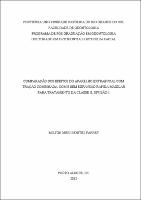| Share record |


|
Please use this identifier to cite or link to this item:
https://tede2.pucrs.br/tede2/handle/tede/1179| Document type: | Tese |
| Title: | Comparação dos efeitos do aparelho extrabucal com tração combinada, com e sem expansão rápida maxilar para tratamento da Classe II, Divisão 1 |
| Author: | Farret, Milton Meri Benitez |
| Advisor: | Lima, Eduardo Martinelli Santayana de |
| Abstract (native): | O objetivo deste estudo foi avaliar os efeitos do Extrabucal com tração combinada, usado isoladamente ou associado à expansão maxilar, sobre os molares superiores, maxila, mandíbula e a relação maxilomandibular como primeira fase de tratamento da maloclusão de Classe II. A amostra consistiu de 61 indivíduos divididos em três grupos: Grupo 1 (n=20), com Extrabucal com tração combinada (AEB); Grupo 2 (n=21), com Extrabucal com tração combinada associado à expansão rápida maxilar (AEB+ERM) e Grupo 3 (n=20), Classe I como controle. No Grupo 1 e no Grupo 2 os indivíduos foram tratados até a relação molar de Classe I ser atingida.. Os resultados mostraram deslocamento distal dos primeiros molares superiores em ambos os grupos experimentais (P< 0,001), com inclinação distal muito maior no Grupo 1 (AEB) (P< 0,001). Houve restrição do deslocamento anterior da maxila nos dois Grupos, mas maior no Grupo 2 entre T1 e T2 ( AEB+ERM) (P<0,05) mas quando comparado entre os grupos, não houve diferença estatística e rotação horária da maxila nos dois Grupos, mas de maneira significativa no Grupo 1 (AEB) (P<0.05). Foi observada projeção mandibular entre T1(início do tratamento) e T2 (final do tratamento) no Grupo 2 (P<0,05), mas nenhuma diferença significativa foi encontrada entre outros grupos (P>0,05). A relação maxilomandibular melhorou em ambos os grupos experimentais (P<0,01), mas a variação foi maior no Grupo 2 (P<0,05). Houve rotação anti-horária mandibular, embora não sendo estatisticamente significativa. Considerando os resultados é possível concluir que o tratamento com ambos os protocolos foi eficiente e os resultados foram mais significativos no Grupo 2 (AEB+ERM), com menor tempo de tratamento e com menos efeitos indesejáveis. |
| Abstract (english): | The aim of this study was to verify the effects of headgear with combined traction used alone or associated with rapid maxillary expansion on the upper molars, maxilla, mandible and maxillomandibular anteroposterior relationship, as the first step of treatment of Class II malocclusion. The sample comprised 61 patients divided into 3 groups: Group 1, headgear combined traction (CH); Group 2, CH + rapid maxillary expansion (CH + RME); and Group 3, control (CG). In Group 1, patients were treated by headgear with combined traction until a Class I molar relationship was reached. In Group 2, the protocol for headgear was the same; however, the patients received rapid maxillary expansion previously. The results showed distal displacement of molars for both experimental groups (P < 0.001), with distal inclination only in Group 1 (CH) (P < 0.001). There was restriction of the forward growth of the maxilla in Group 2 (CH + RME) (P <0 .05) and clockwise rotation of the maxilla in Group 1 (CH) (P < 0.05). Mandibular projection was observed between T1 and T2 in group 2 (P < 0.05), but no significant difference was found between the other groups (P > 0.05). The maxillomandibular relationship improved in both experimental groups (P < 0.01); however, the variation was greater in group 2 (P < 0.05). Considering the results, it is possible to conclude that the treatment with both protocols was efficient; however, the results were more significant for Group 2 (CH + RME), with shorter treatment time and with less collateral effects. |
| Keywords: | ODONTOLOGIA ORTODONTIA ORTOPEDIA FACIAL CEFALOMETRIA MALOCLUSÃO |
| CNPQ Knowledge Areas: | CNPQ::CIENCIAS DA SAUDE::ODONTOLOGIA |
| Language: | por |
| Country: | BR |
| Publisher: | Pontifícia Universidade Católica do Rio Grande do Sul |
| Institution Acronym: | PUCRS |
| Department: | Faculdade de Odontologia |
| Program: | Programa de Pós-Graduação em Odontologia |
| Citation: | FARRET, Milton Meri Benitez. Comparação dos efeitos do aparelho extrabucal com tração combinada, com e sem expansão rápida maxilar para tratamento da Classe II, Divisão 1. 2012. 110 f. Tese (Doutorado em Odontologia) - Pontifícia Universidade Católica do Rio Grande do Sul, Porto Alegre, 2012. |
| Access type: | Acesso Aberto |
| URI: | http://tede2.pucrs.br/tede2/handle/tede/1179 |
| Issue Date: | 22-Jun-2012 |
| Appears in Collections: | Programa de Pós-Graduação em Odontologia |
Files in This Item:
| File | Description | Size | Format | |
|---|---|---|---|---|
| 440017.pdf | Texto Completo | 4.15 MB | Adobe PDF |  Download/Open Preview |
Items in DSpace are protected by copyright, with all rights reserved, unless otherwise indicated.




